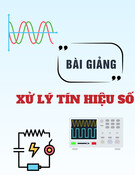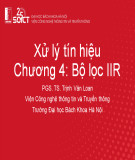Chapter 4 FIR filtering and Convolution
Click to edit Master subtitle style
Nguyen Thanh Tuan, M.Eng. Department of Telecommunications (113B3) Ho Chi Minh City University of Technology Email: nttbk97@yahoo.com
Content
Block processing methods
Convolution: direct form, convolution table Convolution: LTI form, LTI table Matrix form Flip-and-slide form Overlap-add block convolution method
Sample processing methods FIR filtering in direct form
Digital Signal Processing 2 FIR Filtering and Convolution
Introduction
Block processing methods: data are collected and processed in blocks.
FIR filtering of finite-duration signals by convolution Fast convolution of long signals which are broken up in short segments DFT/FFT spectrum computations Speech analysis and synthesis Image processing
Sample processing methods: the data are processed one at a time- with each input sample being subject to a DSP algorithm which transforms it into an output sample. Real-time applications Digital audio effects processing Digital control systems Adaptive signal processing
Digital Signal Processing 3 FIR Filtering and Convolution
1. Block Processing method
The collected signal samples x(n), n=0, 1,…, L-1, can be thought as a
block:
x=[x0, x1, …, xL-1]
The duration of the data record in second: TL=LT
Consider a casual FIR filter of order M with impulse response:
h=[h0, h1, …, hM]
The length (the number of filter coefficients): Lh=M+1
Digital Signal Processing 4 FIR Filtering and Convolution
11.1. Direct form
The convolution in the direct form:
For DSP implementation, we must determine
The range of values of the output index n The precise range of summation in m
index of h(m) 0≤m≤M
Find index n: index of x(n-m) 0≤n-m≤L-1 0 ≤ m ≤ n ≤m+L-1 ≤ M+L-1
Lx=L input samples which is processed by the filter with order M
yield the output signal y(n) of length
Digital Signal Processing 5 FIR Filtering and Convolution
1Direct form
index of h(m) 0≤m≤M
Find index m: index of x(n-m) 0≤n-m≤L-1 n+L-1≤ m ≤ n
The direct form of convolution is given as follows:
with
Thus, y is longer than the input x by M samples. This property
follows from the fact that a filter of order M has memory M and keeps each input sample inside it for M time units.
Digital Signal Processing 6 FIR Filtering and Convolution
Example 1
Consider the case of an order-3 filter and a length of 5-input signal.
Find the output ?
h=[h0, h1, h2, h3] x=[x0, x1, x2, x3, x4 ]
y=h*x=[y0, y1, y2, y3, y4 , y5, y6, y7 ]
Digital Signal Processing 7 FIR Filtering and Convolution
1.2. Convolution table
It can be observed that
Convolution table
The convolution
table is convenient for quick calculation by hand because it displays all required operations compactly.
Digital Signal Processing 8 FIR Filtering and Convolution
Example 2
Calculate the convolution of the following filter and input signals?
h=[1, 2, -1, 1], x=[1, 1, 2, 1, 2, 2, 1, 1]
Solution:
sum of the values along anti-diagonal line yields the output y:
y=[1, 3, 3, 5, 3, 7, 4, 3, 3, 0, 1]
Note that there are Ly=L+M=8+3=11 output samples.
Digital Signal Processing 9 FIR Filtering and Convolution
1.3. LTI Form
LTI form of convolution:
Consider the filter h=[h0, h1, h2, h3] and the input signal x=[x0, x1, x2,
x3, x4 ]. Then, the output is given by
We can represent the input and output signals as blocks:
Digital Signal Processing 10 FIR Filtering and Convolution
1.3. LTI Form
LTI form of convolution:
LTI form of convolution provides a more intuitive way to under stand the linearity and time-invariance properties of the filter.
Digital Signal Processing 11 FIR Filtering and Convolution
Example 3
Using the LTI form to calculate the convolution of the following
filter and input signals?
h=[1, 2, -1, 1], x=[1, 1, 2, 1, 2, 2, 1, 1] Solution:
Digital Signal Processing 12 FIR Filtering and Convolution
1.4. Matrix Form
Based on the convolution equations
we can write
x is the column vector of the Lx input samples. y is the column vector of the Ly =Lx+M put samples. H is a rectangular matrix with dimensions (Lx+M)xLx .
Digital Signal Processing 13 FIR Filtering and Convolution
1.4. Matrix Form
It can be observed that H has the same entry along each diagonal.
Such a matrix is known as Toeplitz matrix.
Matrix representations of convolution are very useful in some
applications: Image processing Advanced DSP methods such as parametric spectrum estimation and adaptive
filtering
Digital Signal Processing 14 FIR Filtering and Convolution
Example 4
Using the matrix form to calculate the convolution of the following
filter and input signals?
h=[1, 2, -1, 1], x=[1, 1, 2, 1, 2, 2, 1, 1] Solution: since Lx=8, M=3 Ly=Lx+M=11, the filter matrix is
11x8 dimensional
Digital Signal Processing 15 FIR Filtering and Convolution
1.5. Flip-and-slide form
The output at time n is given by
Flip-and-slide form of convolution
The flip-and-slide form shows clearly the input-on and input-off
transient and steady-state behavior of a filter.
Digital Signal Processing 16 FIR Filtering and Convolution
1.6. Transient and steady-state behavior
From LTI convolution:
The output is divided into 3 subranges:
Transient and steady-state filter outputs:
Digital Signal Processing 17 FIR Filtering and Convolution
1.7. Overlap-add block convolution method
As the input signal is infinite or extremely large, a practical approach is to divide the long input into contiguous non-overlapping blocks of manageable length, say L samples.
Overlap-add block convolution method:
Digital Signal Processing 18 FIR Filtering and Convolution
Example 5
Using the overlap-add method of block convolution with each bock length L=3, calculate the convolution of the following filter and input signals?
h=[1, 2, -1, 1], x=[1, 1, 2, 1, 2, 2, 1, 1]
Solution: The input is divided into block of length L=3
The output of each block is found by the convolution table:
Digital Signal Processing 19 FIR Filtering and Convolution
Example 5
The output of each block is given by
Following from time invariant, aligning the output blocks according to theirs absolute timings and adding them up gives the final results:
Digital Signal Processing 20 FIR Filtering and Convolution
2. Sample processing methods
The direct form convolution for an FIR filter of order M is given by
Introduce the internal states
Sample processing algorithm
Sample processing methods are
convenient for real-time applications
Fig: Direct form realization of Mth order filter
Digital Signal Processing 21 FIR Filtering and Convolution
Example 6
Consider the filter and input given by
Using the sample processing algorithm to compute the output and
show the input-off transients.
Digital Signal Processing 22 FIR Filtering and Convolution
Example 6
Digital Signal Processing 23 FIR Filtering and Convolution
Example
Digital Signal Processing 24 FIR Filtering and Convolution
Hardware realizations
The FIR filtering algorithm can be realized in hardware using DSP
chips, for example the Texas Instrument TMS320C25
MAC: Multiplier Accumulator
Digital Signal Processing 25 FIR Filtering and Convolution
Hardware realizations
The signal processing methods can efficiently rewritten as
In modern DSP chips, the two
operations
can carried out with a single instruction.
The total processing time for each input sample of Mth order filter:
where Tinstr is one instruction cycle in about 30-80 nanoseconds. For real-time application, it requires that
Digital Signal Processing 26 FIR Filtering and Convolution
Example 7
What is the longest FIR filter that can be implemented with a 50 nsec per instruction DSP chip for digital audio applications with sampling frequency fs=44.1 kHz ?
Solution:
Digital Signal Processing 27 FIR Filtering and Convolution
Homework 1
Digital Signal Processing 28 FIR Filtering and Convolution
Homework 2
Digital Signal Processing 29 FIR Filtering and Convolution
Homework 3
Digital Signal Processing 30 FIR Filtering and Convolution
Homework 4
Compute the output y(n) of the filter h(n) = {1, -1, 1, -1} and input
x(n) = {1, 2, 3, 4, @, -3, 2, -1}
Digital Signal Processing 31 FIR Filtering and Convolution
Homework 5
Compute the convolution, y = h ∗ x, of the filter and input, h(n) = {1, -1, -1, 1} , x(n) = {1, 2, 3, 4, @, -3, 2, -1} using the following methods: 1. The convolution table. 2. The LTI form of convolution, arranging the computations in a
table form.
3. The overlap-add method of block convolution with length-3
input blocks.
4. The overlap-add method of block convolution with length-4
input blocks.
5. The overlap-add method of block convolution with length-5
input blocks.
Digital Signal Processing 32 FIR Filtering and Convolution
















![Đề thi cuối học kì 2 môn Cấu trúc dữ liệu và giải thuật [kèm đáp án/mới nhất]](https://cdn.tailieu.vn/images/document/thumbnail/2025/20251014/lakim0906/135x160/89711760416179.jpg)


![Tài liệu Nhập môn Học máy và Khai phá Dữ liệu [chuẩn nhất]](https://cdn.tailieu.vn/images/document/thumbnail/2025/20251001/kimphuong1001/135x160/531759303870.jpg)






